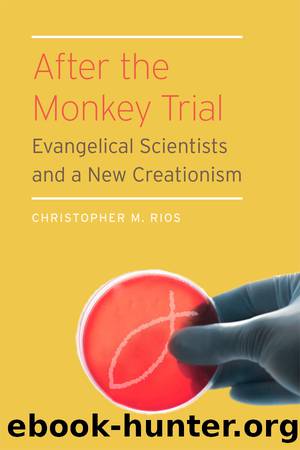After the Monkey Trial by Rios Christopher M.;

Author:Rios, Christopher M.;
Language: eng
Format: epub
Publisher: Fordham University Press
The Bube Era
Bube began his presidency with firm convictions about the controversies and challenges facing the ASA. He never hid his disregard for creationism, and he frequently allowed the frustration of others to speak for him. This was the context for the letter by Gordon Lewthwaite, offered at the beginning of this chapter, commending the ASAâs approach to the issues. In a similar letter from the winter of 1968, Bube quoted an anonymous member who urged the ASA to provide an alternative Christian view to young-earth creationism, because âChristians who are bound to the fetters of only 10 or 15 thousand years [for the age of the earth] are a laughing stock to scientists.â39 Nevertheless, Bube remained committed to the ideals he expressed in 1965 and consistently encouraged open dialogue about the issues that threatened to divide the ASA. Despite his own views, he recognized antievolutionary creationism as a theologically valid, if unnecessary, position that deserved a voice.
But Bubeâs vision and concerns extended beyond any single issue. Soon after 1965, his frustration over the Encounter controversy fermented into dissatisfaction with the ASAâs broader accomplishments. Within two years he was lamenting the ASAâs anonymity among professional scientists and its inability to influence the scientific community. The entire organization, he wrote in 1967, was âvirtually non-existent.â The results were twofold:
(1) The scientific community is almost completely unaware of the existence, purpose, and potential contributions of the ASA. (2) The majority of Christian men of science regard the ASA as rather an outdated organ of a narrow doctrinal view, in spite of the fact that a small minority of hyperconservative Christians consider the ASA to be constantly on the verge of apostasy.40
In other words, while most were unaware of the ASA, the rest were likely incorrect in their assessment of it. Such obscurity rendered the organization impotent. The situation, Bube insisted, required action. The ASA had to redefine and broaden its objectives so that it might become known for open conversation about important issues where truth was sought after rather than defined. It had to expand its publication program without censorship. It had to âaffirm clearly the validity of the scientific endeavor in understanding the natural world.â41 And it had to communicate its ideas in Christian and scientific circles more effectively. After he became president, these convictions deepened. Emphasizing the dual identity of ASA members, he described them as both a âcommunity of the faithful, who have committed themselves and their lives to Jesus Christâ as well as a part of the scientific community âwho have committed themselves to the understanding, control, and utilization of the natural world through the scientific disciplines.â42 Only by fully embracing both aspects of its character could the ASA realize its potential. Accordingly, Bube began his presidency with an unambiguous challenge:
Is the ASA to be restricted to the activity of a small religio-scientific sect, forever fighting anew the battles of yesteryear, and speaking aloud to a constantly diminishing audience? Or is the ASA to be a fellowship of
Download
This site does not store any files on its server. We only index and link to content provided by other sites. Please contact the content providers to delete copyright contents if any and email us, we'll remove relevant links or contents immediately.
Signature in the Cell: DNA and the Evidence for Intelligent Design by Stephen C. Meyer(2879)
Real Sex by Lauren F. Winner(2867)
The Holy Spirit by Billy Graham(2777)
The Secret Power of Speaking God's Word by Joyce Meyer(2754)
The Gnostic Gospels by Pagels Elaine(2399)
Jesus by Paul Johnson(2229)
Devil, The by Almond Philip C(2205)
23:27 by H. L. Roberts(2144)
The Nativity by Geza Vermes(2115)
Chosen by God by R. C. Sproul(2055)
All Things New by John Eldredge(2052)
Angels of God: The Bible, the Church and the Heavenly Hosts by Mike Aquilina(1869)
Angels by Billy Graham(1844)
The Return of the Gods by Erich von Daniken(1841)
Knowing God by J.I. Packer(1724)
Jesus of Nazareth by Joseph Ratzinger(1708)
Evidence of the Afterlife by Jeffrey Long(1705)
The Gnostic Gospel of St. Thomas by Tau Malachi(1680)
How To Be Born Again by Billy Graham(1670)
